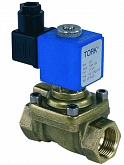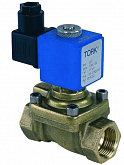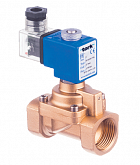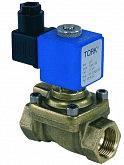Price range
Connection size
Connection type
Flow
Function
Pressure
Temperature

A solenoid valve is an electrically actuated valve that is usually used to shut off water flow, steam, water-based solutions of oils or neutral gases. In our assortment, you can find classic two-way versions, and more complex solutions can be delivered if needed as well.
Detailed information about TORK solenoid valves TORK Solenoid Valve FAQs

€ 88,03

€ 136,81

€ 241,09

€ 120,89
Electromagnetic solenoid valves are used to shut off the flow of water, steam, water-based solutions, oils or neutral gases. Their purpose is mainly water distribution, heating and cooling systems or air conditioning. Some special types of solenoid valves are designed specifically for high-pressure devices. They work by being closed without voltage or open without voltage. Classic two-way electromagnetic solenoid valves are most often used. However, more complex solutions are available as needed. The inlet and outlet are in commonly used standard threaded variations. Temperature, pressure and other parameters are always specified for each type of product.
At the same time, the electromagnetic valve can also be equipped with manual control, as is the case with fail-safe models, for example.
Directly operated electromagnetic valves
There are valves where the main cone is directly connected to the armature (core) of the electromagnet, i.e. the electromagnet directly opens the passage through the valve without the need for a pressure difference. These valves work from zero pressure differences, but the maximum pressure difference is dependent on the attraction force of the electromagnet (the greater the opening of the valve, the smaller the pressure difference, with the same size of the electromagnet).
Indirectly operated electromagnetic valves
This is how we refer to valves where the main cone is not directly connected to the armature (core) of the electromagnet, i.e. the electromagnet only opens the auxiliary discharge channel (auxiliary seat), thereby releasing the pressure above the main cone (piston, diaphragm) and the passage through the valve is opened using a minimum pressure difference. These valves always work from some minimum pressure difference. When the pressure difference falls below the minimum limit, the cone starts to restrict the passage of the valve, but the auxiliary seat remains open even without the need for minimum pressure. the difference. A minimum pressure difference is not required to close the solenoid valve, the spring ensures the closing. With these valves, it is possible to control different sizes of valves with the same size electromagnet, because the auxiliary seat that controls the electromagnet always has the same clearance.